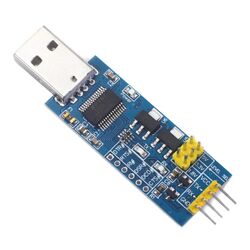FT232RL
FT232RL USB-to-Serial Adapter
The FT232RL is an expensive, high-performance USB-to-UART bridge developed by FTDI (Future Technology Devices International). Commonly known for its reliability and feature-rich design, it facilitates serial communication between USB-equipped hosts and TTL-level devices such as microcontrollers, FPGAs, and development boards.
Overview
- 💡 Integrated Features: The FT232RL combines a USB 2.0 full-speed controller, UART interface, internal oscillator, and EEPROM into a single chip.
- 🔌 Versatile Voltage Support: Operates with I/O voltages ranging from 1.8V to 5V, ensuring compatibility with a wide array of logic levels.
- 📈 High Data Throughput: Supports baud rates up to 3 Mbps, catering to high-speed serial communication needs.
- 🧰 Driver Support: Offers native drivers for Windows, macOS, and Linux, simplifying integration across platforms.
Note: When using FTDI-based devices, ensure they are sourced from reputable suppliers to avoid counterfeit issues, otherwise you risk getting a counterfeit chip which FTDI will intentionally brick using a bogus driver!
FTDI has faced significant backlash over its approach to counterfeit chip detection and enforcement, particularly concerning its driver updates that affected non-genuine devices.
See notes at the end for more information.
FT232RL Breakout Module
Breakout boards featuring the FT232RL chip provide easy access to its functionalities, making them popular for prototyping and development purposes.
Pin Configuration
| Pin Label | Function | Notes |
|---|---|---|
| GND | Ground | Common reference point; connect first |
| TXD | Transmit Data | Serial output from adapter (connect to target RX) |
| RXD | Receive Data | Serial input to adapter (connect to target TX) |
| VCC | Module Power Supply | Typically connected to 5V USB power |
| VCCIO | I/O Voltage Reference | Determines logic level for TXD/RXD; connect to 3.3V or 5V as needed |
| 3V3OUT | 3.3V Output | Provides up to 50 mA; useful for powering low-current 3.3V devices |
| DTR | Data Terminal Ready | Used for auto-reset in programming microcontrollers |
| CTS | Clear to Send | Hardware flow control input |
| RTS | Request to Send | Hardware flow control output |
Voltage Configuration Tips
- Logic Level Selection: The VCCIO pin sets the logic level for UART signals. Connect it to 3.3V for 3.3V logic devices or to 5V for 5V logic devices.
- Powering the Module: The module is typically powered via the VCC pin connected to the USB's 5V supply. Ensure that the target device's voltage requirements align with the module's output.
- 3.3V Output Usage: The 3V3OUT pin provides a regulated 3.3V output, suitable for powering low-current devices. Do not use it to power the entire system.
Wiring Instructions
- Ground Connection: Always connect the GND pin first to establish a common ground between the adapter and the target device.
- Serial Connections: Cross-connect the serial lines—adapter's TXD to target's RXD, and adapter's RXD to target's TXD.
- Voltage Matching: Ensure that the logic levels of the adapter and the target device are compatible. Use level shifters if necessary.
- Flow Control: If not using hardware flow control, leave the CTS and RTS pins unconnected or configure them appropriately in software.
Applications
- Microcontroller Programming: Commonly used for programming Arduino, ESP8266, STM32, and other microcontrollers via UART.
- Serial Debugging: Facilitates serial communication for debugging embedded systems.
- Firmware Updates: Enables firmware flashing on devices that support UART-based updates.
- Data Logging: Useful in applications requiring serial data logging to a PC.
⚠️ Controversies and Criticisms
2014 Driver Controversy: Bricking Counterfeit Chips
In September 2014, FTDI released a Windows driver update that, upon detecting a non-genuine FTDI chip, would reprogram its USB Product ID to "0000". This action rendered the device unrecognizable to any operating system, effectively "bricking" it. The update was distributed via Windows Update, leading to widespread unintended consequences for users unaware they possessed counterfeit chips.
The driver’s End User License Agreement (EULA) included a clause stating that using the driver with non-genuine FTDI products could "irretrievably damage" them.
The electronics community criticized FTDI's approach, arguing that it punished end-users who were often unaware of the counterfeit nature of their devices.
In response to the backlash, FTDI withdrew the driver and stated that future versions would notify users of non-genuine devices in a non-invasive manner.
2016 Driver Update: Injecting Garbage Data
In early 2016, FTDI released another driver update that, instead of bricking counterfeit devices, altered their behavior by sending a repeating ASCII string "NON GENUINE DEVICE FOUND!" over the serial connection.
This method was also met with criticism, as it could cause erratic behavior in systems relying on serial communication, potentially leading to data corruption or system malfunctions.
Community Response and Alternatives
The controversies led many developers and companies to seek alternatives to FTDI chips to avoid potential issues. Alternatives such as Silicon Labs' CP210x series and WCH's CH340 series gained popularity due to their reliability and less aggressive counterfeit detection methods.
Additionally, open-source communities began promoting solutions that do not require proprietary drivers, reducing dependency on specific manufacturers and mitigating risks associated with driver updates.
FTDI's aggressive measures to combat counterfeit chips, particularly through driver updates that altered device functionality or rendered them inoperable, have been widely criticized. While protecting intellectual property is a legitimate concern, the methods employed by FTDI have raised ethical questions and led to a loss of trust among developers and end-users.
